Food safety isn’t just about wearing fancy hairnets and washing hands – it’s a crucial responsibility that keeps customers healthy and businesses thriving. Food handlers serve as the frontline defenders against foodborne illnesses making split-second decisions that can impact public health.
While most people know the basics like proper handwashing and temperature control food handlers must master a complex web of safety protocols. From proper storage techniques to cross-contamination prevention these professionals juggle multiple responsibilities throughout their shifts. But there’s one common misconception about their duties that often leads to confusion in commercial kitchens.
Understanding a food handler’s duties regarding food safety include all of the following practices except to: is just as important as knowing what is. Let’s explore the essential duties of food handlers and uncover which widely believed practice actually falls outside their scope of work.
A Food Handler’s Duties Regarding Food Safety Include All of the Following Practices Except To:
Personal Hygiene
- Washing hands thoroughly with soap for 20 seconds before handling food
- Wearing clean uniforms daily
- Using hair restraints to prevent contamination
- Removing jewelry except plain wedding bands
- Covering cuts with waterproof bandages gloves
Temperature Control
- Monitoring hot foods at 135°F (57°C) or above
- Keeping cold foods at 41°F (5°C) or below
- Checking internal temperatures with calibrated thermometers
- Recording temperature readings at scheduled intervals
- Taking immediate action when temperatures fall outside safe zones
Cross-Contamination Prevention
- Using separate cutting boards for raw meat seafood vegetables
- Storing raw products below ready-to-eat foods
- Cleaning sanitizing equipment between uses
- Maintaining designated prep areas for different food types
- Changing gloves between tasks
Storage Management
- Rotating stock using First-In-First-Out (FIFO) method
- Labeling containers with contents expiration dates
- Storing food 6 inches off the floor
- Maintaining proper storage temperatures
- Inspecting deliveries for quality compliance
- Following proper dish washing procedures
- Maintaining clean work surfaces
- Sanitizing high-touch areas frequently
- Using appropriate chemical concentrations
- Testing sanitizer strength regularly
| Temperature Zone | Safe Range | Monitoring Frequency |
|---|---|---|
| Hot Holding | ≥135°F | Every 4 hours |
| Cold Holding | ≤41°F | Every 4 hours |
| Cooking | Varies | Each batch |
| Cooling | 135°F-41°F | Every 2 hours |
Understanding Personal Hygiene Requirements
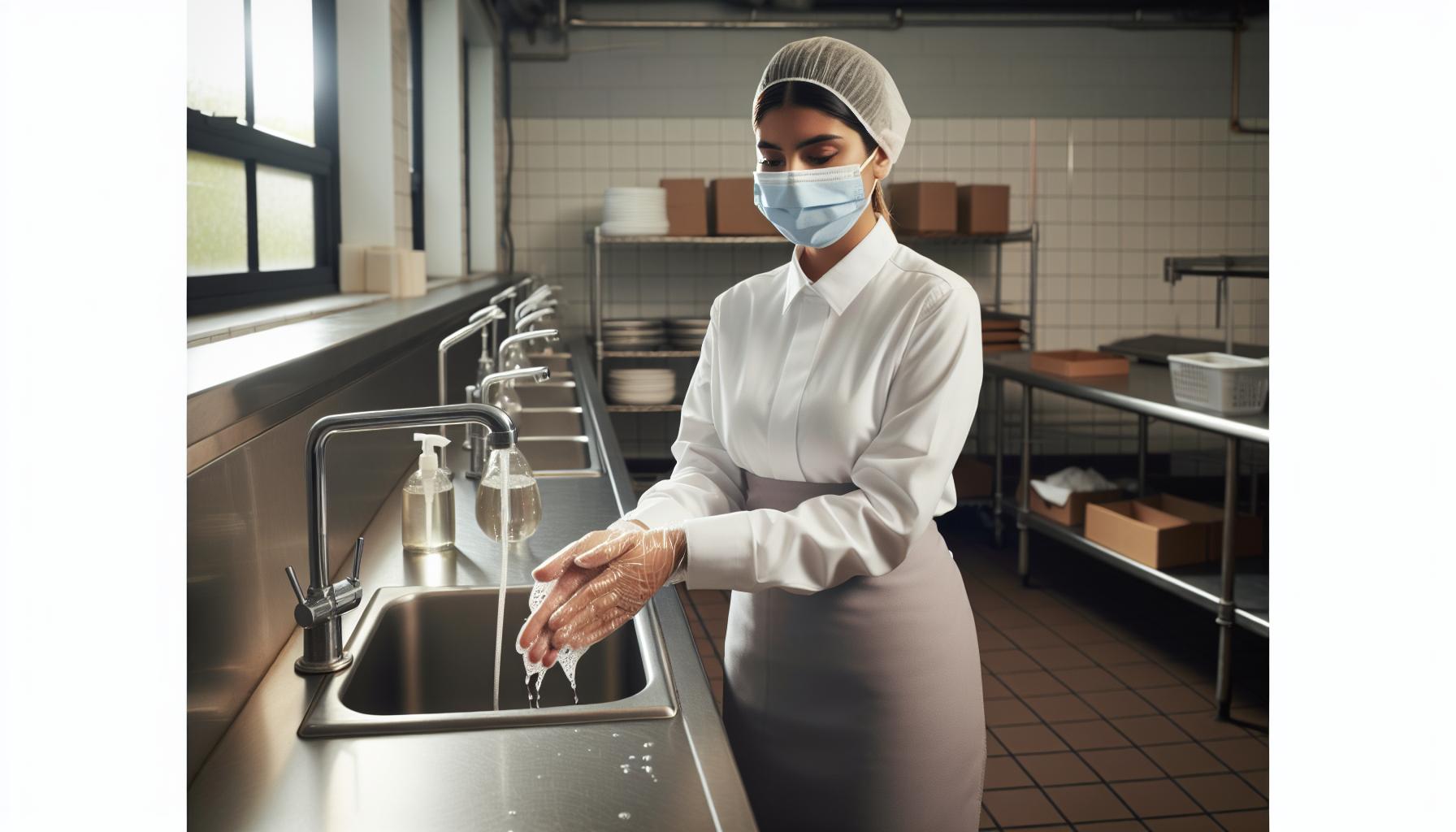
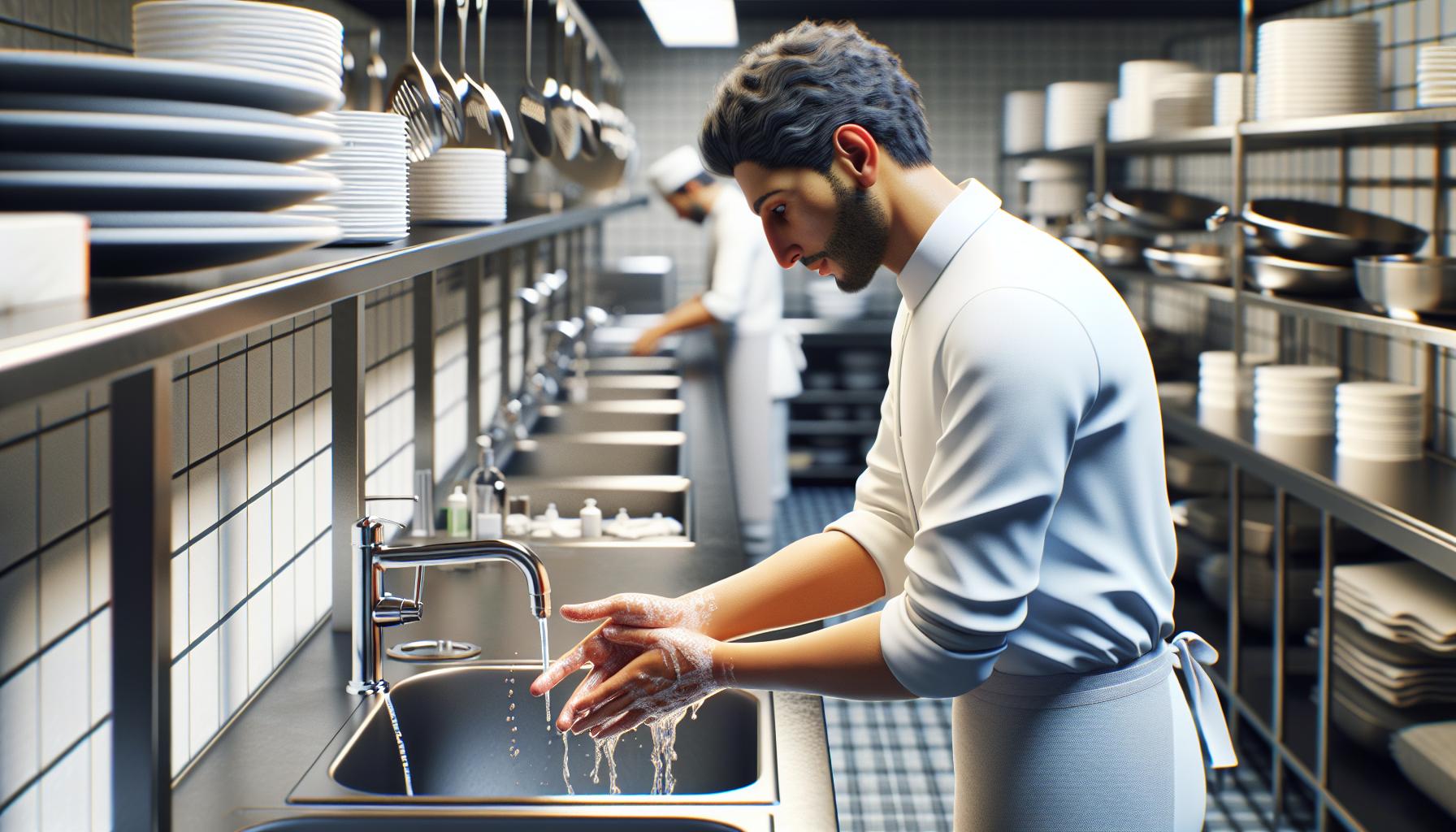
Personal hygiene forms the foundation of food safety practices in food service establishments. Food handlers maintain specific hygiene standards to prevent foodborne illness transmission through direct contact contamination.
Hand Washing Protocols
Food handlers follow a 20-second handwashing procedure with soap under running water. Handwashing occurs before starting work, after using restrooms, touching raw meat, handling garbage, eating, drinking or smoking. The process includes:
- Wetting hands with warm water
- Applying soap to create lather
- Scrubbing palms, fingers, nails, wrists for 20 seconds
- Rinsing thoroughly under clean water
- Drying with single-use paper towels
- Using paper towel to turn off faucet
Hand sanitizers serve as additional protection after washing, not as a replacement for proper handwashing.
Proper Work Attire Guidelines
Food handlers wear clean, appropriate attire to protect food from contamination. Required clothing includes:
- Clean uniforms or aprons changed daily
- Hair restraints covering all hair
- Clean, non-slip closed-toe shoes
- Short, clean fingernails without polish
- No jewelry except plain wedding bands
- Face masks during food preparation
Food handlers store personal items like phones, bags or outer clothing in designated areas away from food preparation zones. They change soiled uniforms immediately to maintain hygiene standards throughout their shift.
Safe Food Handling Procedures
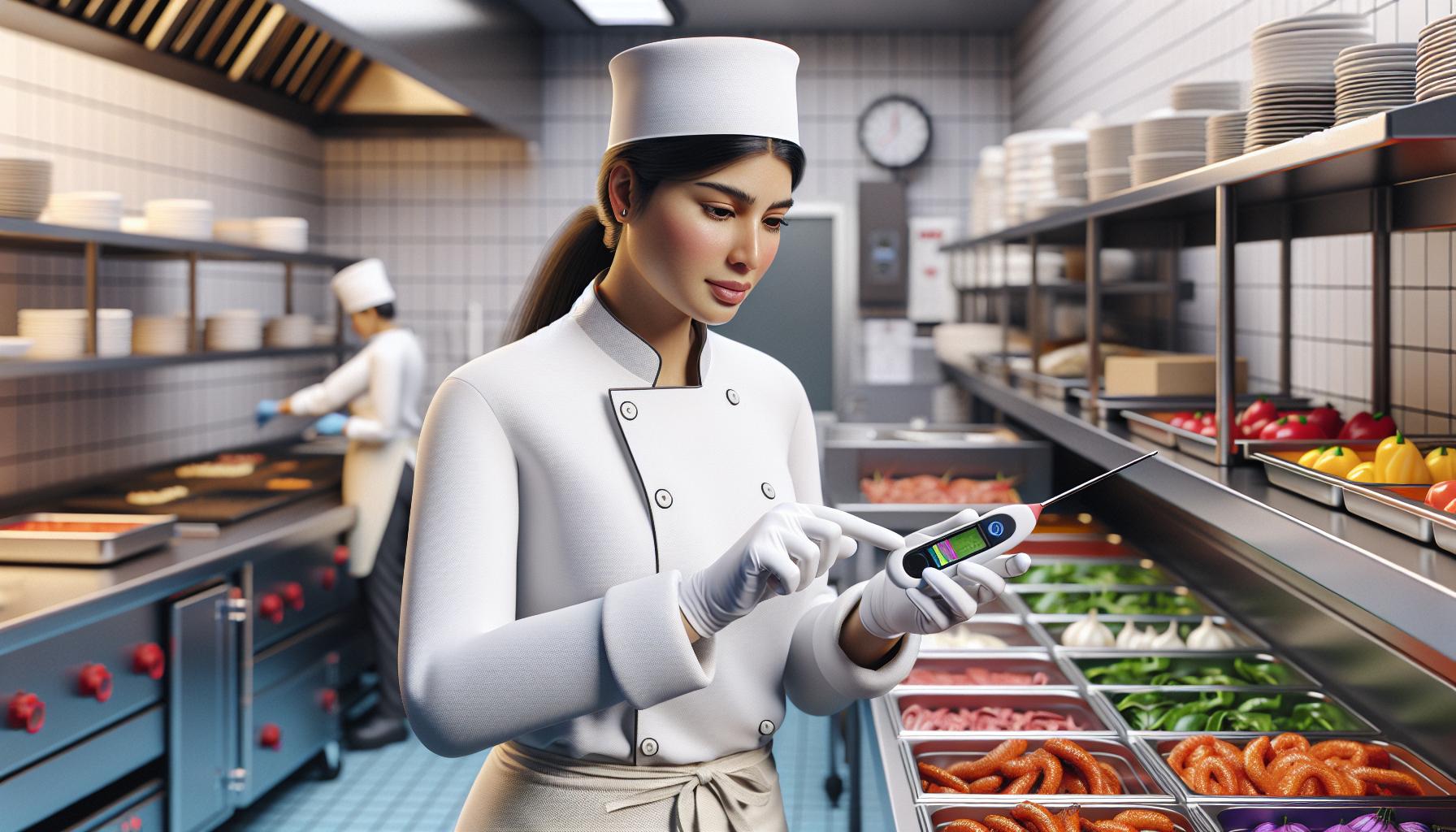
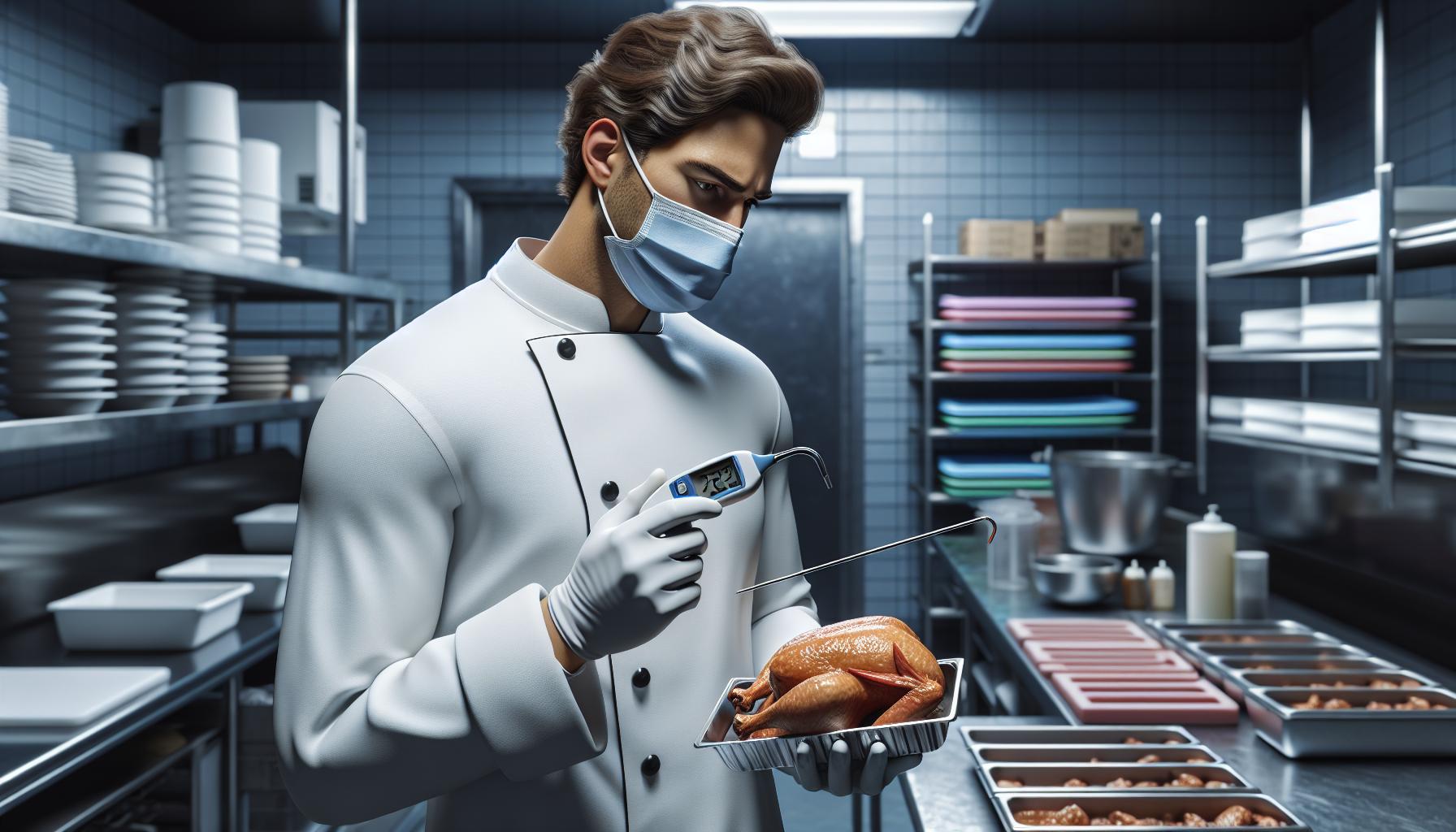
Food handlers implement specific protocols to maintain food safety throughout preparation, storage, and service. These procedures focus on preventing foodborne illnesses through systematic control measures and regular monitoring.
Temperature Control Standards
Food handlers monitor temperatures in the danger zone between 40°F and 140°F (4°C to 60°C). Hot foods stay above 140°F (60°C) during service, while cold foods remain below 40°F (4°C). Staff check internal food temperatures every 4 hours using calibrated thermometers. A temperature log documents readings for both hot and cold items. Cooking temperatures vary by food type:
| Food Item | Minimum Internal Temperature |
|---|---|
| Poultry | 165°F (74°C) |
| Ground Meat | 160°F (71°C) |
| Seafood | 145°F (63°C) |
| Eggs | 145°F (63°C) |
Cross-Contamination Prevention
Food handlers separate raw meats from ready-to-eat foods during storage and preparation. Color-coded cutting boards designate specific food types: red for raw meat, green for produce, yellow for poultry. Staff store raw items below cooked foods in refrigeration units. Separate utensils remain designated for each food category. Equipment receives sanitization between different food types. Food handlers change gloves after handling raw ingredients. Storage containers maintain proper spacing on shelves. Clean preparation surfaces receive sanitization between tasks. Staff members wash hands after touching raw foods.
Common Food Handler Mistakes to Avoid

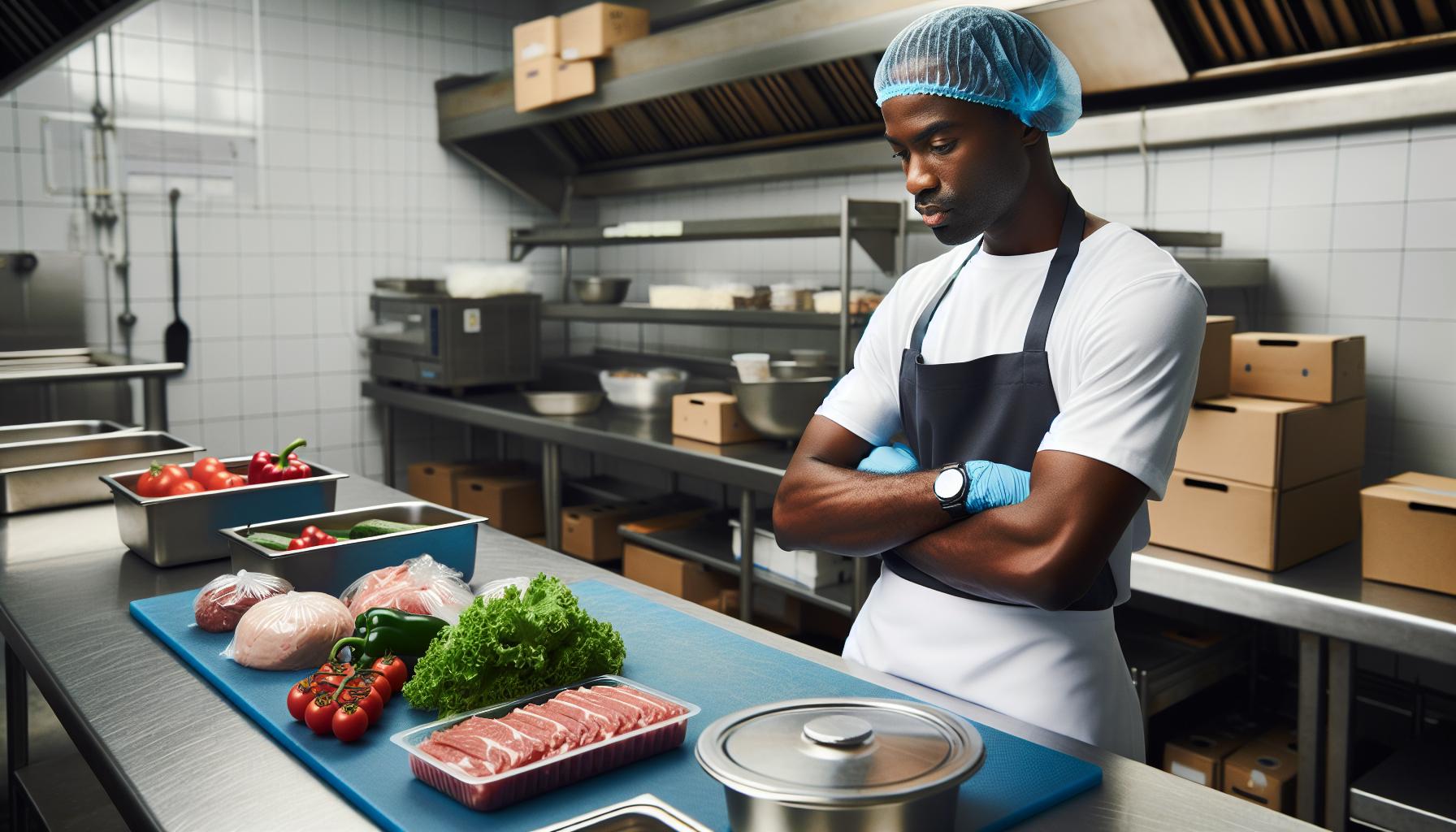
Food handlers make several critical mistakes that compromise food safety standards. Understanding these errors helps maintain proper food safety protocols in commercial kitchens.
Unauthorized Recipe Modifications
A food handler’s duties regarding food safety include all of the following practices except to: Food handlers violate safety protocols by making unauthorized changes to established recipes. Altering cooking temperatures or times puts customers at risk of foodborne illness. Adding or substituting ingredients without approval creates potential allergen hazards. Modifying portion sizes affects proper cooking requirements for food safety. The standardization of recipes ensures consistent food safety outcomes through:
- Precise cooking temperatures for pathogen elimination
- Specific ingredient quantities for allergen control
- Established cooking times for proper food doneness
- Validated cooling methods for temperature control
- Documented storage requirements for food preservation
- Operating without proper food handling certifications
- Neglecting mandatory temperature monitoring schedules
- Failing to maintain updated HACCP documentation
- Skipping required sanitization procedures
- Using unapproved food sources or suppliers
- Storing chemicals near food preparation areas
- Operating with expired health permits
- Missing required employee health screenings
Workplace Safety and Sanitation Standards
Food handlers implement specific sanitation protocols to maintain a safe food preparation environment. These standards protect both workers and consumers while ensuring compliance with health regulations.
Cleaning and Sanitizing Equipment
Food handlers follow a three-step process for equipment sanitation: washing, rinsing and sanitizing. The washing phase removes visible debris using hot water at 110°F with detergent. Rinsing eliminates chemical residue from cleaning agents through clear, running water. Sanitizing requires either chemical solutions at specific concentrations or hot water at 180°F for 30 seconds. Common sanitizing methods include:
- Chlorine solutions at 50-100 ppm for food contact surfaces
- Quaternary ammonium compounds at 200-400 ppm for non-food surfaces
- Iodine solutions at 12.5-25 ppm for equipment sanitization
- Rotating stock using FIFO (First-In-First-Out) methods
- Labeling all containers with contents and expiration dates
- Maintaining separate zones for raw and ready-to-eat foods
- Conducting weekly inspections for signs of pest activity
Non-Essential Duties Outside Food Handler Scope
Food handlers focus primarily on safe food preparation and handling practices. Several responsibilities fall outside their core duties and belong to other food service professionals.
Menu Planning and Development
Menu planning remains the responsibility of executive chefs culinary directors. Food handlers execute established recipes without modifying ingredients portions or cooking methods. Creating seasonal menus designing new dishes calculating food costs establishing portion sizes belong to management roles. The creative aspects of menu development including flavor profiles presentation standards ingredient combinations stay under the purview of trained culinary professionals who understand market trends customer preferences nutritional requirements.
Financial Management Tasks
Financial operations exist separate from food handler responsibilities. Tasks like inventory cost analysis budget planning vendor negotiations fall under management jurisdiction. Processing payments managing payroll tracking expenses coordinating with suppliers handling cash transactions belong to accounting administrative staff. Food handlers don’t participate in pricing decisions profit margin calculations or financial reporting activities. Restaurant financial planning purchasing decisions resource allocation remain strictly management functions overseen by trained business professionals.
A Vital Role in Maintaining Food Safety
Food handlers play a vital role in maintaining food safety but they must clearly understand the boundaries of their responsibilities. Their duties focus primarily on hands-on food safety practices including proper hygiene temperature control and contamination prevention. a food handler’s duties regarding food safety include all of the following practices except to: they don’t handle menu planning financial management or pricing decisions.
Understanding these distinctions helps create a more efficient and safer food service environment. When food handlers concentrate on their core responsibilities they can better protect public health and maintain the high standards required in food service establishments.



